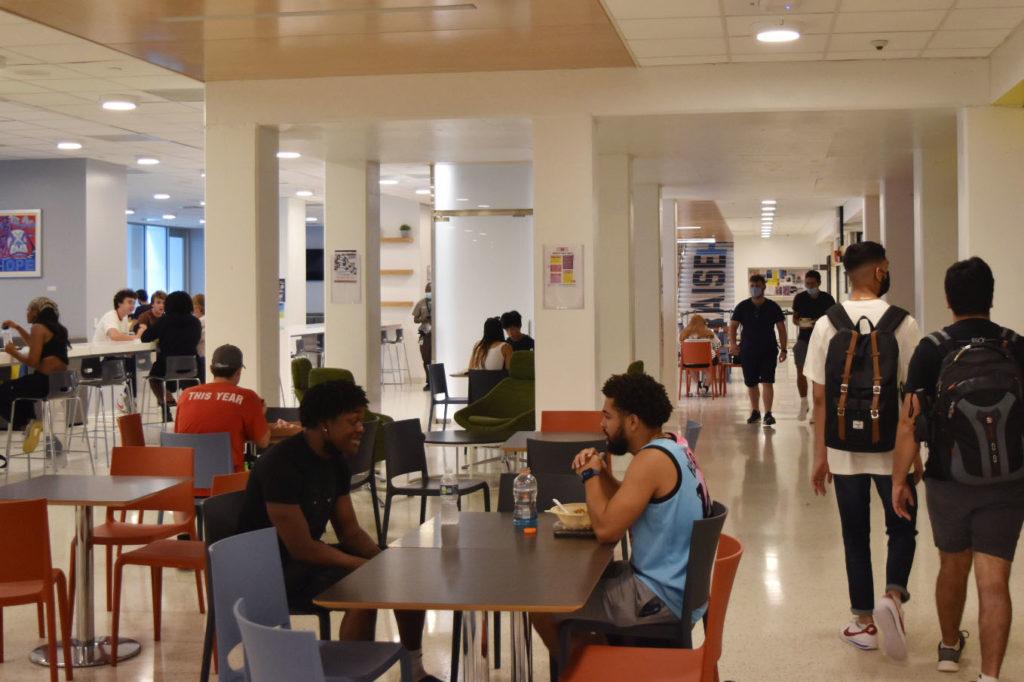With only two of GW’s three planned Foggy Bottom dining halls set to open in the fall, campus dining capacity is set to lag behind that of other D.C. universities.
The dining halls opening in Shenkman and Thurston halls will seat approximately 319 and 225 students, respectively, according to documents obtained by The Hatchet. Other dining halls in the District, like those at Georgetown and Howard universities, can seat more than double that amount despite hosting about 4,000 fewer students.
The documents, which were created in December, provide blueprints of the campus dining halls that will open next school year, including the vendors expected to provide food service at each location, the seating arrangements and other amenities.
Leo O’Donovan Dining Hall, the main campus dining facility at Georgetown University, seats between 1,000 to 1,150 students, and the dining halls at Howard University have space for approximately 2,300 people. The Mary Graydon Dining Center at American University can seat about 675 students.
But the undergraduate populations at those universities are all lower than that of GW. Georgetown, American and Howard reported about 8,000 undergraduates in fall of 2020, compared to GW’s 12,000.
University spokesperson Tim Pierce said GW’s dining halls will be able to accommodate the student population next year, but he declined to say how many diners each dining hall can seat. Pierce also declined to say how many students signed up for each of the seven new dining plans.
“Based on current projections of seats and students on meal plans, over 5,000 students will be able to be served during each meal period,” Pierce said.
The ground floor of Shenkman Hall, where Potbelly Sandwich Shop was previously located, will feature two rotating “retail concepts” and a market and juice bar with approximately 54 seats. The lower level will contain 265 seats distributed in a variety of table sizes and seating options with seven “micro restaurant” vendor stations.
Thurston Hall will hold seven vendor stations, multiple seating selections, a gaming area and community spaces designed for “student and staff interaction.”
Officials announced in April that the District House dining hall, which was previously slated to open in the fall, will remain under construction until later in the school year. At the start of the fall, undergraduates who opt to use meal swipes will be limited to the dining facilities in Shenkman or Thurston halls, which seat a total of approximately 544 people. Students can also trek over to the Mount Vernon Campus dining hall located at The Eatery at Pelham Commons, which will hold approximately 260 students.
Eric Grynaviski, an associate professor of political science and international affairs and the chair of the Faculty Senate’s physical facilities committee, said he was “concerned” about GW’s dining hall maps because its seating capacity is half that of other local universities.
“Oftentimes, we’ve discovered that we’ve gotten ourselves into hot water because we haven’t necessarily done all the legwork in the planning that was necessary in order to have a successful experience, especially at the beginning of fall,” he said in a Faculty Senate meeting last month.
Dozens of students and faculty reported mold outbreaks around campus upon the return to in-person instruction this year, while experts said administrative oversight may have caused the outbreak.
He said he realized that the Thurston dining hall would clearly lack the capacity to hold the building’s residents on a “busy lunch day” during a tour of the renovated building. Thurston Hall has been under construction since May 2020 and is slated to open at the start of the school year.
“I am very worried about the effect that that will have on the student experience if there are one- or two-hour lines,” he said.
Interim University President Mark Wrighton said at last month’s Faculty Senate meeting that Seth Weinshel, the associate vice president of business services, said the dining halls will be “up and running” next academic year.
“We are mindful that Thurston Hall, as well as we’re doing in terms of reconstructing it, is still not complete and I have my fingers crossed that we remain on budget and on time and that will be essential to a great experience,” Wrighton said.










